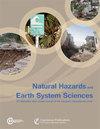Prediction of natural dry-snow avalanche activity using physics-based snowpack simulations
IF 4.7
2区 地球科学
Q1 GEOSCIENCES, MULTIDISCIPLINARY
引用次数: 2
Abstract
Abstract. Predicting the timing and size of natural snow avalanches is crucial for local and regional decision makers but remains one of the major challenges in avalanche forecasting. So far, forecasts are generally made by human experts interpreting a variety of data and drawing on their knowledge and experience. Using avalanche data from the Swiss Alps and one-dimensional physics-based snowpack simulations for virtual slopes, we developed a model predicting the probability of dry-snow avalanches occurring in the region surrounding automated weather stations based on the output of a recently developed instability model. This new avalanche day predictor was compared with benchmark models related to the amount of new snow. Evaluation on an independent data set demonstrated the importance of snow stratigraphy for natural avalanche release, as the avalanche day predictor outperformed the benchmark model based on the 3 d sum of new snow height (F1 scores: 0.71 and 0.65, respectively). The averaged predictions of both models resulted in the best performance (F1 score: 0.75). In a second step, we derived functions describing the probability for certain avalanche size classes. Using the 24 h new snow height as proxy of avalanche failure depth yielded the best estimator of typical (median) observed avalanche size, while the depth of the deepest weak layer, detected using the instability model, provided the better indicator regarding the largest observed avalanche size. Validation of the avalanche size estimator on an independent data set of avalanche observations confirmed these findings. Furthermore, comparing the predictions of the avalanche day predictors and avalanche size estimators with a 21-year data set of re-analysed regional avalanche danger levels showed increasing probabilities for natural avalanches and increasing avalanche size with increasing danger level. We conclude that these models may be valuable tools to support forecasting the occurrence of natural dry-snow avalanches.利用基于物理的积雪模拟预测自然干雪崩活动
摘要预测自然雪崩的时间和规模对当地和区域决策者至关重要,但仍然是雪崩预测的主要挑战之一。到目前为止,预测通常是由人类专家解释各种数据并利用他们的知识和经验做出的。利用来自瑞士阿尔卑斯山的雪崩数据和基于一维物理的虚拟斜坡积雪模拟,我们基于最近开发的不稳定模型的输出,开发了一个模型,预测在自动气象站周围区域发生干雪崩的概率。这个新的雪崩日预测器与与新雪量相关的基准模型进行了比较。对独立数据集的评估表明,雪地层学对自然雪崩释放的重要性,因为雪崩日预测器优于基于新雪高度三维总和的基准模型(F1得分分别为0.71和0.65)。两种模型的平均预测结果最佳(F1得分:0.75)。在第二步中,我们推导了描述某些雪崩大小类的概率的函数。利用24 h新雪高度作为雪崩破坏深度的代表,可以最好地估计典型(中值)观测到的雪崩大小,而利用不稳定性模型探测到的最深弱层深度可以更好地预测最大观测到的雪崩大小。在雪崩观测的独立数据集上验证雪崩大小估计器证实了这些发现。此外,将雪崩日预测器和雪崩规模估计器的预测结果与21年来重新分析的区域雪崩危险级别数据集进行比较,发现自然雪崩的概率随着危险级别的增加而增加,雪崩规模也随着危险级别的增加而增加。我们认为,这些模型可能是支持预测自然干雪雪崩发生的有价值的工具。
本文章由计算机程序翻译,如有差异,请以英文原文为准。
求助全文
约1分钟内获得全文
求助全文
来源期刊
CiteScore
7.60
自引率
6.50%
发文量
192
审稿时长
3.8 months
期刊介绍:
Natural Hazards and Earth System Sciences (NHESS) is an interdisciplinary and international journal dedicated to the public discussion and open-access publication of high-quality studies and original research on natural hazards and their consequences. Embracing a holistic Earth system science approach, NHESS serves a wide and diverse community of research scientists, practitioners, and decision makers concerned with detection of natural hazards, monitoring and modelling, vulnerability and risk assessment, and the design and implementation of mitigation and adaptation strategies, including economical, societal, and educational aspects.

 求助内容:
求助内容: 应助结果提醒方式:
应助结果提醒方式:


